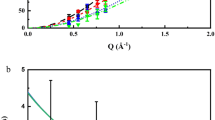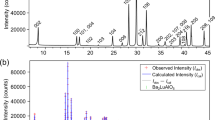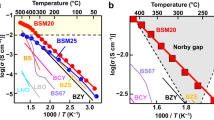Abstract
Acceptor-doped barium zirconate is a promising proton-conducting oxide for various applications, for example, electrolysers, fuel cells or methane-conversion cells. Despite many experimental and theoretical investigations there is, however, only a limited understanding as to how to connect the complex microscopic proton motion and the macroscopic proton conductivity for the full range of acceptor levels, from diluted acceptors to concentrated solid solutions. Here we show that a combination of density functional theory calculations and kinetic Monte Carlo simulations enables this connection. At low concentrations, acceptors trap protons, which results in a decrease of the average proton mobility. With increasing concentration, however, acceptors form nanoscale percolation pathways with low proton migration energies, which leads to a strong increase of the proton mobility and conductivity. Comparing our simulated proton conductivities with experimental values for yttrium-doped barium zirconate yields excellent agreement. We then predict that ordered dopant structures would not only strongly enhance the proton conductivities, but would also enable one- or two-dimensional proton conduction in barium zirconate. Finally, we show how the properties of other dopants influence the proton conductivity.
This is a preview of subscription content, access via your institution
Access options
Access Nature and 54 other Nature Portfolio journals
Get Nature+, our best-value online-access subscription
$29.99 / 30 days
cancel any time
Subscribe to this journal
Receive 12 print issues and online access
$259.00 per year
only $21.58 per issue
Buy this article
- Purchase on Springer Link
- Instant access to full article PDF
Prices may be subject to local taxes which are calculated during checkout






Similar content being viewed by others
Data availability
The data that support the findings of this study are available from M.M. upon reasonable request.
Code availability
The self-written codes iCon and MOCASSIN for the KMC simulations are available from M.M. upon reasonable request.
Change history
09 March 2020
A Correction to this paper has been published: https://doi.org/10.1038/s41563-020-0654-3
References
Iwahara, H., Yajima, T., Hibino, T., Ozaki, K. & Suzuki, H. Protonic conduction in calcium, strontium and barium zirconates. Solid State Ionics 61, 65–69 (1993).
Kreuer, K. D. Proton-conducting oxides. Annu. Rev. Mater. Res. 33, 333–359 (2003).
Bi, L., Boulfrad, S. & Traversa, E. Steam electrolysis by solid oxide electrolysis cells (SOECs) with proton-conducting oxides. Chem. Soc. Rev. 43, 8255–8270 (2014).
Bae, K. et al. Demonstrating the potential of yttrium-doped barium zirconate electrolyte for high-performance fuel cells. Nat. Commun. 8, 14553 (2017).
Malerød-Fjeld, H. et al. Thermo-electrochemical production of compressed hydrogen from methane with near-zero energy loss. Nat. Energy 2, 923–931 (2017).
Yamazaki, Y. et al. Proton trapping in yttrium-doped barium zirconate. Nat. Mater. 12, 647–651 (2013).
Kim, D. Y., Miyoshi, S., Tsuchiya, T. & Yamaguchi, S. Defect chemistry and electrochemical properties of BaZrO3 heavily doped with Fe. ECS Trans. 45, 161–170 (2012).
Tsidilkovski, V., Kuzmin, A., Putilov, L. & Balakireva, V. H/D isotope effect for hydrogen solubility in BaZr0.9Y0.1O3–δ: chemical expansion studies. Solid State Ionics 301, 170–175 (2017).
Toyoura, K., Meng, W., Han, D. & Uda, T. Preferential proton conduction along a three-dimensional dopant network in yttrium-doped barium zirconate: a first-principles study. J. Mater. Chem. A 6, 22721–22730 (2018).
Imai, G., Nakamura, T. & Amezawa, K. Defect chemistry and thermodynamic properties of proton dissolution into BaZr0.9Y0.1O3−δ. Solid State Ionics 303, 12–15 (2017).
Buannic, L., Sperrin, L., Dervişoğlu, R., Blanc, F. & Grey, C. P. Proton distribution in Sc-doped BaZrO3: a solid state NMR and first principle calculations analysis. Phys. Chem. Chem. Phys. 20, 4317–4328 (2018).
Gomez, M. A. et al. Ordered yttrium concentration effects on barium zirconate structure, proton binding sites and transition states. Solid State Ionics 304, 126–134 (2017).
Takahashi, H. et al. First-principles calculations for the energetics of the hydration reaction of acceptor-doped BaZrO3. Chem. Mater. 29, 1518–1526 (2017).
Bork, N., Bonanos, N., Rossmeisl, J. & Vegge, T. Simple descriptors for proton-conducting perovskites from density functional theory. Phys. Rev. B 82, 014103 (2010).
Sundell, P. G., Björketun, M. E. & Wahnström, G. Density-functional calculations of prefactors and activation energies for H diffusion in BaZrO3. Phys. Rev. B 76, 94301 (2007).
Gomez, M. A., Griffin, M. A., Jindal, S., Rule, K. D. & Cooper, V. R. The effect of octahedral tilting on proton binding sites and transition states in pseudo-cubic perovskite oxides. J. Chem. Phys. 123, 94703 (2005).
Björketun, M. E., Sundell, P. G., Wahnström, G. & Engberg, D. A kinetic Monte Carlo study of proton diffusion in disordered perovskite structured lattices based on first-principles calculations. Solid State Ionics 176, 3035–3040 (2005).
Ahmed, I. et al. Structural study and proton conductivity in Yb-doped BaZrO3. Solid State Ionics 178, 515–520 (2007).
Ahmed, I. et al. Crystal structure and proton conductivity of BaZr0.9Sc0.1O3−δ. J. Am. Ceram. Soc. 91, 3039–3044 (2008).
Shirpour, M., Merkle, R., Lin, C. T. & Maier, J. Nonlinear electrical grain boundary properties in proton conducting Y-BaZrO3 supporting the space charge depletion model. Phys. Chem. Chem. Phys. 14, 730–740 (2012).
Pornprasertsuk, R., Kosasang, O., Somroop, K., Jinawath, S. & Prinz, F. B. Proton conductivity studies of Y-doped barium zirconate: theoretical and experimental approaches. ECS Trans. 25, 367–381 (2010).
Kreuer, K.-D. et al. Proton conducting alkaline earth zirconates and titanates for high drain electrochemical applications. Solid State Ionics 145, 295–306 (2001).
Kosasang, O., Somroop, K., Chindaudom, P. & Pornprasertsuk, R. Effect of doping concentration on the proton conductivity of Y-doped BaZrO3 thin films. ECS Trans. 19, 145–151 (2009).
Cervera, R. B. et al. Structural study and proton transport of bulk nanograined Y-doped BaZrO3 oxide protonics materials. Solid State Ionics 179, 236–242 (2008).
Pornprasertsuk, R., Ramanarayanan, P., Musgrave, C. B. & Prinz, F. B. Predicting ionic conductivity of solid oxide fuel cell electrolyte from first principles. J. Appl. Phys. 98, 3340–3348 (2005).
Merinov, B. & Goddard, W. Proton diffusion pathways and rates in Y-doped BaZrO3 solid oxide electrolyte from quantum mechanics. J. Chem. Phys. 130, 194707 (2009).
Gomez, M. A. & Liu, F.-J. Protons in Al doped BaZrO3 escape dopant traps to access long range proton conduction highways. Solid State Ionics 252, 40–47 (2013).
Kochetova, N., Animitsa, I., Medvedev, D., Demin, A. & Tsiakaras, P. Recent activity in the development of proton-conducting oxides for high-temperature applications. RSC Adv. 6, 73222–73268 (2016).
Kreuer, K. D. On the complexity of proton conduction phenomena. Solid State Ionics 136, 149–160 (2000).
Gomez, M. A., Shepardson, D., Nguyen, L. T. & Kehinde, T. Periodic long range proton conduction pathways in pseudo-cubic and orthorhombic perovskites. Solid State Ionics 213, 8–13 (2012).
Gomez, M. A. et al. The effect of yttrium dopant on the proton conduction pathways of BaZrO3, a cubic perovskite. J. Chem. Phys. 132, 214709 (2010).
Kim, D., Miyoshi, S., Tsuchiya, T. & Yamaguchi, S. Percolation conductivity in BaZrO3-BaFeO3 solid solutions. Solid State Ionics 262, 875–878 (2014).
Grieshammer, S., Grope, B. O. H., Köttgen, J. & Martin, M. A combined DFT+U and Monte Carlo study on rare earth doped ceria. Phys. Chem. Chem. Phys. 16, 9974–9986 (2014).
Ostwald, W. Zur Theorie der Lösungen. Z. Phys. Chem. 2, 36–37 (1888).
Bjerrum, N. Investigations on association of ions. I. Kgl. Dansk. Vidensk. Selsk. Math.-fys. Medd. 7, 1–48 (1926).
Dieterich, W., Dürr, O., Pendzig, P., Bunde, A. & Nitzan, A. Percolation concepts in solid state ionics. Physica A 266, 229–237 (1999).
Kreuer, K. D. Aspects of the formation and mobility of protonic charge carriers and the stability of perovskite-type oxides. Solid State Ionics 125, 285–302 (1999).
Tao, S. & Irvine, J. T. S. Conductivity studies of dense yttrium-doped BaZrO3 sintered at 1325 °C. J. Solid State Chem. 180, 3493–3503 (2007).
Essam, J. W. Percolation theory. Rep. Prog. Phys. 43, 833–912 (1980).
Björketun, M. E., Sundell, P. G. & Wahnström, G. Effect of acceptor dopants on the proton mobility in BaZrO3: a density functional investigation. Phys. Rev. B 76, 54307 (2007).
Perdew, J. P., Burke, K. & Ernzerhof, M. Generalized gradient approximation made simple. Phys. Rev. Lett. 77, 3865–3868 (1996).
Blöchl, P. E. Projector augmented-wave method. Phys. Rev. B 50, 17953–17979 (1994).
Kresse, G. & Furthmüller, J. Efficient iterative schemes for ab initio total-energy calculations using a plane-wave basis set. Phys. Rev. B 54, 11169–11186 (1996).
Kresse, G. & Joubert, D. From ultrasoft pseudopotentials to the projector augmented-wave method. Phys. Rev. B 59, 1758–1775 (1999).
Henkelman, G., Uberuaga, B. P. & Jonsson, H. A climbing image nudged elastic band method for finding saddle points and minimum energy paths. J. Chem. Phys. 113, 9901–9904 (2000).
Sheppard, D., Xiao, P., Chemelewski, W., Johnson, D. D. & Henkelman, G. A generalized solid-state nudged elastic band method. J. Chem. Phys. 136, 74103 (2012).
Henkelman, G. & Jónsson, H. A dimer method for finding saddle points on high dimensional potential surfaces using only first derivatives. J. Chem. Phys. 111, 7010–7022 (1999).
Monkhorst, H. J. & Pack, J. D. Special points for Brillouin-zone integrations. Phys. Rev. B 13, 5188–5192 (1976).
iCon (RWTH Aachen University, 2014).
MOCASSIN (RWTH Aachen University, 2018).
Murch, G. E. Monte Carlo calculation as an aid in teaching solid state diffusion. Am. J. Phys. 47, 78–80 (1979).
Matsumoto, M. & Nishimura, T. Mersenne twister: a 623-dimensionally equidistributed uniform pseudo-random number generator. ACM Trans. Model. Comput. Simul. 8, 3–30 (1998).
O’Neill, M. E. PCG: A Family of Simple Fast Space-Efficient Statistically Good Algorithms for Random Number Generation HMC-CS-2014-0905 (2014).
Grope, B. O. H., Zacherle, T., Nakayama, M. & Martin, M. Oxygen ion conductivity of doped ceria: a kinetic Monte Carlo study. Solid State Ionics 225, 476–483 (2012).
Acknowledgements
The authors gratefully acknowledge the computing time granted by the JARA Vergabegremium and provided on the JARA Partition part of the supercomputer CLAIX at RWTH Aachen University within the projects jara0141 and rwth0189.
Author information
Authors and Affiliations
Contributions
M.M. led the development of the concept and supervised the research. F.M.D. performed the DFT and KMC calculations, collected the data and analysed them. C.A. also performed DFT calculations and contributed data. J.P.A., S.E. and S.G. developed the program MOCASSIN and delivered technical support. J.P.A. also created the simulation cells for the superstructures. S.Y. provided critical suggestions concerning the analytical procedure. M.M. and F.M.D. wrote the paper with contributions from all the authors.
Corresponding author
Ethics declarations
Competing interests
The authors declare no competing interests.
Additional information
Publisher’s note Springer Nature remains neutral with regard to jurisdictional claims in published maps and institutional affiliations.
Supplementary information
Supplementary Information
Supplementary discussion and Figs. 1 and 2.
Source data
Source Data Fig. 2
Numerical data used to generate Fig. 2
Source Data Fig. 3
Numerical data used to generate Fig. 3
Source Data Fig. 5
Numerical data used to generate Fig. 5
Source Data Fig. 6
Numerical data used to generate Fig. 6
Rights and permissions
About this article
Cite this article
Draber, F.M., Ader, C., Arnold, J.P. et al. Nanoscale percolation in doped BaZrO3 for high proton mobility. Nat. Mater. 19, 338–346 (2020). https://doi.org/10.1038/s41563-019-0561-7
Received:
Accepted:
Published:
Issue Date:
DOI: https://doi.org/10.1038/s41563-019-0561-7
This article is cited by
-
Sintering-induced cation displacement in protonic ceramics and way for its suppression
Nature Communications (2023)
-
Role of BaZrO3 Phase on Microstructure and Ionic Conductivity of 8YSZ
Journal of Materials Engineering and Performance (2022)
-
Solid Oxide Electrolysis of H2O and CO2 to Produce Hydrogen and Low-Carbon Fuels
Electrochemical Energy Reviews (2021)
-
A review on experimental and theoretical studies of perovskite barium zirconate proton conductors
Emergent Materials (2021)
-
Influence of Sc concentration on transport properties of CaHf1-xScxO3-α
Ionics (2021)



